| Republic of Dranland | |
|---|---|

| |
|
Motto: | |

| |
| Government | |
| Foundation | 2178 |
| Government Type | Presidential Republic |
| Steward of the Realm | Guinevere Morgan-Caleb (NAP) |
| Demographics | |
| Capital (and largest city) |
Iglesia Mayor |
| Official Languages | Kyo, Egelian (Draniano), Draddwyr, Luthoran |
| Dominant Languages | Dranianos, Kyo, Draddwyr |
| Area | 1,201,800 km² |
| Population
- 3524 Census |
99,635,473 82.85 people per km² |
| Currency | Dran (DRA) |
| Sport | Skeet shooting |
| Animal | Stag |
| Provinces | |
| Elbian, Loren, Magadonia, Ulbrach, Valdor | |
| Nation ID Number: 52 | |
See also: Dankuk
Dranland, officially the Republic of Dranland, is a country north-west of Dovani. With an area of 751,125 sq mi (1,201,800 sq km), Dranland is situated c.600 mi (970 km) east of Trigunia and c.180 mi (290 km) north east of Egelion. The Republic is made up of five Provinces: Loren, Ulbrach, Valdor, Magadonia and Elbian.
History
Geography & Climate
Deep fjords indent the coasts of Dranland. The land itself is a geologically young basalt plateau, averaging 2,000 ft (610 m) in height (c.6,950 ft/2,120 m high, is the highest point) and culminating in vast icefields. There are about 200 volcanoes, many of them still active. Hot springs abound and are used for inexpensive heating; the great Geysir is particularly famous.
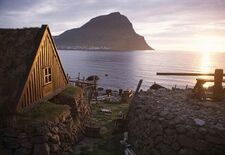
A view of a fishing cooperative near Soyolango, off the coast of Elbian
The climate is relatively mild and humid (especially in the west and south), and almost subtropical around Elbian, owing to the proximity of the North Terran Drift; however, North and East Dranland have a polar, tundralike climate. Grasses predominate; timber is virtually absent, and much of the land is barren. (Some of this is a result of human habitation, which led to deforestation and overgrazing.) Only about one fourth of the peninsula is habitable, and practically all the larger inhabited places are located on the coast.
Government & Politics
Dranland is a presidential republic. The head of state and government is the Steward of the Realm, who is directly elected to four-year terms. The Steward of the Realm is the chief representative of the nation and he/she also appoints the executive cabinet, composed of twelve ministers who are approved by Legislative Council.
The Legislative Council, Dranland's unicameral legislature, holds the most power in government and is responsible for drafting and approving all laws and treaties. The president has little power over parliament and he/she has no ability to veto legislation. At times, presidents, through MLCs of their political party, may submit legislation to the Parliament. Like the president, members of parliament are directly elected to four-year terms.
The judiciary of Dranland is headed by the Supreme Court, and throughout the nation there is a system of regional and other types of courts.
Politics
For most of its history, excepting the Cheng Socialist and the Drexler dictatorships, Dranland has enjoyed relatively stable, democratic rule. Most political power lays with Parliament, and political parties play a major role in shaping governmental policy. In general, politics is very party-centered and in the legislatures party members vote in blocs, not individually. However this does has not prevented Dranland from having strong political personalities who stand out in parliament or in the leadership of the political parties.
As a multi-party state, the formation of government relies heavily on the formation of coalition governments. Usually it is the norm for ideologically common parties to partner in government. However this has not always been the case in Dranland. At times there have been coalitions formed out of a common opposition to a political force, just as anti-communism. This was scene in the presidencies of Earl Branstead-Smith and Park Jae-yung.
Past Governance
Following the Dranian Seung Revolution in 2967, Dranland was a single-party state, ruled by the Jegug-ui Hyeogmyeong Jeonseon (제국의 혁명 전선 - Imperial Revolutionary Front). After the fall of the Cheng Socialist State, democratic parties reestablished the monarchy and began to liberalize the economy.
Before July 3336, Dranland was a constitutional monarchy, officially titled as the Kingdom of Dranland. Leading the monarchy was the Cadwallader Family. During the monarchy the head of state position was split between the hereditary monarch and a directly elected representative of the people, known as the Lord Chancellor. And head of government was the Prime Minister, a position which continued to exist in the republic, until June 3483.
Prior to May 3231, monarchy was headed by the House of Santiago. But in 3231 the National Socialist Revolution abolished the monarchy and Adolf Frederick Drexler declared himself "New Emperor of Dranland;" and King Cristián I was deported from country. After the NSP collapse, efforts of the Royal Democratic Party and Grand National Party, reestablished the monarchy under Cristián and the House of Santiago.
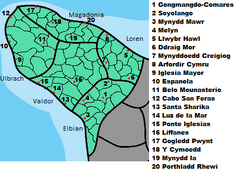
Location of Dranish cities.
Not long after his return, Cristián I abdicated, leaving the throne to Victoria I of Drania. In 3286 a referendum was held questioning whether to maintain the monarchy and it was narrowly decided to keep the monarchy. Following the referendum it was also decided in 3292 that the monarchy would become controlled by the Cadwallader Family.
Administrative Subdivisions
The Republic of Dranland is divided into five first-level subdivisions, called Shires. Each province directly elects a governor and a legislature every four-years. The Shires are further divided into districts and municipalities, as designated by the provincial government.
| Province | Flag | Area | Population | Capital |
|---|---|---|---|---|
| Elbian | 228,000 km² | 19,907,576 | Gongmangdo-Comares | |
| Loren | 174,000 km² | 19,875,567 | Llwybr Hawl | |
| Magadonia | 166,200 km² | 19,923,102 | Porthladd Rhewi | |
| Ulbrach | 271,500 km² | 19,956,620 | Iglesia Mayor | |
| Valdor | 362,100 km² | 19,857,646 | Santa Sharika |
Economy
About 15% of the land is potentially productive, but agriculture, cultivating mainly hay, potatoes, and turnips, is restricted to 0.5% of the total area. Fruits and vegetables are raised in greenhouses. There are extensive grazing lands, used mainly for sheep raising, but also for horses and cattle. Fishing is the most important industry, accounting for 20% of the gross national product (GNP) and 75% of the country's exports. Aside from aluminium smelting and ferrosilicon production, Dranland has little heavy industry and relies on imports for many of the necessities and luxuries of life. More than half of Dranland's GNP comes from the communications, trade, and service industries; Dranland is the new banking centre of the Northeast. Tourism is also important. Most trade was traditionally done with Egelion, New Endralon, Kazulia, the Seleyan countries, and Beluzia. In 2190,
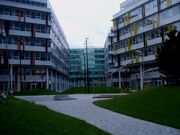
Dranish News - Centre
Dranland's per capita national income was higher than the average for Terra. The country experienced a recession from the late 2180s into the early 2190s, as fish stocks dwindled and world prices for fish and aluminum dropped. However, the economy stabilized in the 2190s and the government continued its policies of diversifying the economy and expanding hydroelectric and geothermal energy resources, thus reducing dependence on oil imports.
The Dranian Seung Revolution in 2968 brought the country's economy under centralized command, with the nationalization of all industries and banks and the redistribution of agricultural land. Due to isolationist policies, foreign trade declined dramatically. Moreover, the Holy Kingdom followed an official policy of Songun (Military First), and as such 75% of the budget was dedicated to defence spending.
The economy recovered when capitalist governments in the 3100s liberalized the economy, particularly under the GNP-PGR government, that took over power in 3246, which introduced a capitalist market economy and conducted large privatization projects, which helped to push the economy. Moreover, the abolition of tariffs on imports and exports as a part of the new free trade policy made goods less expensive and boosted consumption and the exchange of goods with other nations. Trade unions in Dranland do not generally wield great political influence, but play an active part in economic and social life.
Energy
Transportation
Transport in Dranland includes rail, road, naval and aerial system. In earlier times, all important transportation systems were managed by the State. Local transportation was provided by local governments, mostly by private carriers. In 3249, all infrastructure was privatized under the chancellorship of Larissa LeCoultre (GNP).
Rail Transport
National rail passenger transport was provided by the national railway company, until it was privatized in 3249. Freight transport is used mainly by private companies.
Railway network was state-owned and managed by the National Agency for Rail Transport (NART), until it was abolished and sold out to private investors.
Dranian National Railways were the national passenger carrier providing services at the national level. Carrier combines all major cities in the country in all provinces. National passenger carrier operated a service between all important cities in provinces of Dranland. Since 3249, this is managed by private companies.
Road Transport
Dranland has six main highways, which are managed by the National Highway Agency, which is now private. Two sections of highway are going to Kazulia via Comares and Ddraig Môr. Highways have signs H1 - H6.
H1 Iglesia Mayor - Belo Mounasterio - Y Cymoedd
H2 Iglesia Mayor - Española - Ponte Iglesias - Soyolango
H3 Iglesia Mayor - Liffanés - Luz de la Mar - Santa Sharika - Melyn - Comares - Kazulia
H4 Iglesia Mayor - Belo Mounasterio - Cabo San Feras - Godledd Pwynt - Mynydd Iâ - Y Cymoedd
H5 Comares/Melyn - Mynydd Mawr - Soyolango - Arfordir Cymru - Ddraig Môr
H6 Y Cymoedd - Llwybr Hawl - Mynyddoedd Creigiog - Ddraig Môr - Kazulia
Military
The commander-in-chief of the Dranish military is the president, but the Minister of Defense generally wields the most control over military functions. And in the day-to-day operation of the military, the president plays little to no role.
The Dranish Armed Forces are divided into four branches: Army, Navy, Air Force, and Coast Guard. The Dranish military is maintained hugely for the sole purpose of protecting national sovereignty. In recent history Dranland has not participated in any international conflicts; the most recent was the Great Sekowian War, which ended in 2980. However, domestically, the military was in an armed conflict in the 3490s with FERN/ERN terrorists in the Dranish Autonomous Zone.
Education
Higher Education
Universities have existed in Dranland since colonial times, and one of the earliest institutions founded in the nation, and on Dovani, was Gongmangdo University, which was established in 1625. Following the arrival of Egelion, the second university, University of Iglesia Mayor, was founded in 1642.
Today there are number of institutions of higher education in Dranland. Throughout the country there are many two-year vocational and technical schools, about 42% of which are public. Additionally there are a couple dozen universities, which cater to students seeking undergraduate and postgraduate degrees. Most all Dranish students pursue some form of education following secondary school, and its estimated that about 65% of students pursue undergraduate degrees.
Under current government policy, all public institutions of higher education are tuition-free for Dranish citizens and residents. Most private institutions are not tuition-free, since they do not receive government funding; however most Dranish institutions have relatively low tuition costs.
Public 4-Year Universities:
- Dranian Technical University, Iglesia Mayor
- Elbian Military Academy, Gongmangdo-Comares
- Elbian National University, Gongmangdo-Comares
- Greater National University of Elbian, Gongmangdo-Comares
- Greater National University of Loren, Llwybr Hawl
- Greater National University of Magadonia, Porthladd Rhewi
- Greater National University of Ulbrach, Iglesia Mayor
- Greater National University of Valdor, Santa Sharika
- Iglesia Mayor National University, Iglesia Mayor
- Loren National University, Llwybr Hawl
- National University of Law & Government, Santa Sharika
- Northern University, Y Cymoedd
- Santa Sharika National University, Santa Sharika
- University of Agriculture, Luz de la Mar
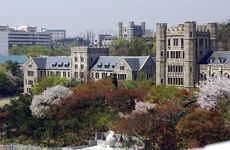
Gongmangdo University
Private 4-Year Universities:
- Dovani International University, Gongmangdo-Comares
- Dranian University, Iglesia Mayor
- First Dranian Private University, Iglesia Mayor
- Gongmangdo University, Gongmangdo-Comares
- University of Cabo San Feras, Cabo San Feras
- University of Comares, Gongmangdo-Comares
- University of Economics, Liffanés
- University of Iglesia Mayor, Iglesia Mayor
- University of Porthladd Rhewi, Porthladd Rhewi
- University of Soyolango, Soyolango
- University of the Universal Church of Terra, Española
- Widefield Business College, Ponte Iglesias
Demographics
TBD
Language
TBD
Religion
Universal Church of Terra
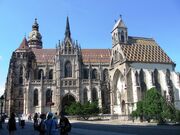
St. Svorad Cathedral of UCT
The Universal Church of Terra (UCT), headed by a hereditary monarch, was formed after 2840 revolution in Dranland. It has since lost its official position in Dranland, as has the monarchy. However, despite an increasing trend towards secularization over recent centuries, the UCT remains influential.
The UCT firmly believes in the Eternal and Omnipotent Light of the Universe, the One, the Creator of All and Everything. It is the religious duty of the Church and all of its Members, to spread the Light and the Faith.
List of Religions in Dranland
| Symbol | Official Name | Percentage |
|---|---|---|
| N/A | Atheist/Agnostic | 24.95% |

|
Selucian Patriarchal Church | 24% |

|
Universal Church of Terra | 20% |

|
Daenism | 12% |

|
Sindo | 4% |

|
Draddwyr Paganism | 10% |
| Luthoran | 3% | |

|
Ameliorate | 2% |

|
Thetanism | 0.05% |
Culture
National Holidays
| Date | Holiday | Province |
|---|---|---|
| 1 January | New Year’s Day | All Provinces |
| 15 March | Day of the Light (Universal Church of Terra) | All Provinces |
| 30 September | Remembrance of the Draddwyr Genocide | All Provinces |
| 1 November | All Saint’s Day | All Provinces |
| 19 November | St. Sharika Day | Valdor Province |
| 20 December | Day of Water & Forests | All Provinces |
Sport
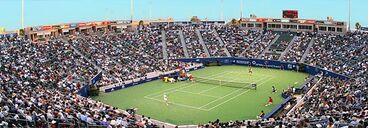
Court of Fuhrer Drexler
The national sport is tennis. It is a game which is played in Dranland by 18th century. National Tennis Cup named Dranish Royal Cup is played in the country every five years in the National Tennis Stadium in Iglesia Mayor. National Cup invite thousands of fans from all regions of Dranland and surroundings states. In May 3192 Parliament ratified the membership of Dranland in the International Tennis Association as the third country in Terra.
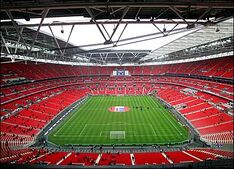
National Stadium
Football is the second most popular game in Dranland. In the recent past there has been a massive increase in the number of football stadiums in all towns and villages in the country. At regional level and national level is playing football league. Football in the country is managed by the Dranish National Football Federation (DNFF). Dranland is a member of Terran FIFA World Cup since October 2744. In the international level the country is represented by Dranish National Football Federation (DNFF). Every five years the King's Cup is played, who plays the top 20 teams in the country.
Ice-hockey is a game played in a few cities in Dranland, especially in northern cities. National ice-hockey staium is situated in Y Cymoedd. Ice-hockey clubs are managed by Dranish National Ice-hockey Federation (DNIF). Currently 13 clubs are registered, and 7 clubs are playing National Ice-hockey League (NIL).
A new game that is gaining more and more fans. Currently are playing winter and summer versions of the game depends of region and climate.
External Links

|
Union of Communist Councilist Republics Seongtaek (Central Capital) | |
| Geography • History • Culture • Economy • Government | ||
|---|---|---|
| History | Baekgu Dynasty • Beonyeongsalm Palace • Dranland • Dranian Zenshō Revolution • Egelian Drania • Flag of Dankuk • Great Kyo Revolution • Federal Park Service • House of Ryeo • House of Santiago • Kyobando Manifesto • Kyo-Indralan Revolutionary War • Timeline of Dranian History • August Revolution • Dranian Civil War | |
| Subdivisions | Republics: Provinces: Metropolitan Cities: City of Labor: | |
| Politics | President of the Rowiet Union • Chairman of the Council of Workers' Commissars • Supreme Rowi Political Parties: CPRU | |
| Demographics | Religion: Aurorian Patriarchal Church • Daenism • Seodongyo • Sindo • Zenshō Ethnicity: Draddwyr • Dranianos • Kazulian • Kyo | |
| Nations of Dovani | ||
| First World | Kyoseon - Indrala - Kazulia - Lourenne - Mikuni-Hulstria - Sekowo - Talmoria - Vorona | |
| Third World | Bianjie - Cifutingan - Dalibor - Degalogesa - Hanzen - Istapali - Kimlien - Kurageri - Liore - Medina - Midway - New Englia - New Verham - North Dovani - Ntoto - Rapa Pile - Statrica - Suyu Llaqta - Ostland - Utari Mosir - Utembo - Xsampa | |





